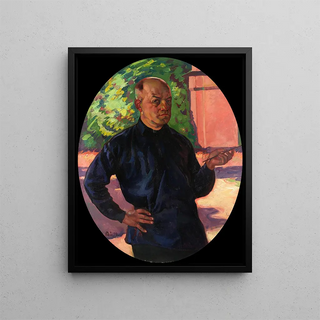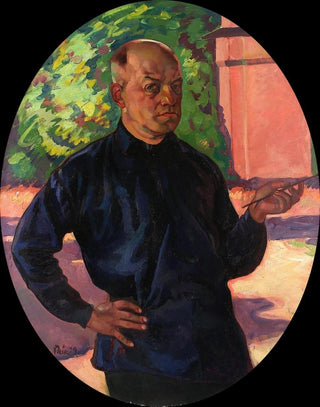Art print | Self-portrait - Nikolai Triik


View from behind

Frame (optional)
Autoportrait Art print - Nikolai Triik – Captivating Introduction
The "Autoportrait" art print by Nikolai Triik is a poignant testament to the artistic soul of the early 20th century. This painting, which transcends mere facial features, invites deep introspection on identity and art itself. Triik, through this portrait, does not merely depict his physical appearance but explores the intricacies of his psyche. Offering us a direct gaze, he encourages reflection on the relationship between the artist and their work, and on how each of us perceives our own image. The Autoportrait - Nikolai Triik art print, with its intensity and depth, thus becomes a mirror in which the viewer can see themselves and question their own existence.
Style and uniqueness of the work
Triik's style is characterized by a bold and innovative approach, blending influences from symbolism and post-impressionism. In "Autoportrait," vibrant colors and expressive brushstrokes create an atmosphere that is both intimate and unsettling. The background, often blurred and indistinct, contrasts with the sharpness of the face, thereby emphasizing the intensity of the emotions conveyed. This stylistic choice highlights the duality of the artist, between the clarity of appearance and the complexity of inner thoughts. Every detail, every shadow, is carefully considered to evoke a sense of depth and mystery, making the work even more captivating. In sum, "Autoportrait" is a visual and emotional exploration that transcends the simple portrait to become a true quest for identity.
The artist and his influence
Nikolai Triik is an emblematic figure of Estonian art, whose work has been marked by an unceasing quest for inner truth. Born in 1884, he forged a unique artistic identity, influenced by European currents while remaining deeply rooted in his native culture. Triik was not only a talented painter but also a passionate teacher, passing on his vision and knowledge to future generations of artists. His introspective approach and desire to capture the human essence made him a pioneer of

Matte finish

View from behind

Frame (optional)
Autoportrait Art print - Nikolai Triik – Captivating Introduction
The "Autoportrait" art print by Nikolai Triik is a poignant testament to the artistic soul of the early 20th century. This painting, which transcends mere facial features, invites deep introspection on identity and art itself. Triik, through this portrait, does not merely depict his physical appearance but explores the intricacies of his psyche. Offering us a direct gaze, he encourages reflection on the relationship between the artist and their work, and on how each of us perceives our own image. The Autoportrait - Nikolai Triik art print, with its intensity and depth, thus becomes a mirror in which the viewer can see themselves and question their own existence.
Style and uniqueness of the work
Triik's style is characterized by a bold and innovative approach, blending influences from symbolism and post-impressionism. In "Autoportrait," vibrant colors and expressive brushstrokes create an atmosphere that is both intimate and unsettling. The background, often blurred and indistinct, contrasts with the sharpness of the face, thereby emphasizing the intensity of the emotions conveyed. This stylistic choice highlights the duality of the artist, between the clarity of appearance and the complexity of inner thoughts. Every detail, every shadow, is carefully considered to evoke a sense of depth and mystery, making the work even more captivating. In sum, "Autoportrait" is a visual and emotional exploration that transcends the simple portrait to become a true quest for identity.
The artist and his influence
Nikolai Triik is an emblematic figure of Estonian art, whose work has been marked by an unceasing quest for inner truth. Born in 1884, he forged a unique artistic identity, influenced by European currents while remaining deeply rooted in his native culture. Triik was not only a talented painter but also a passionate teacher, passing on his vision and knowledge to future generations of artists. His introspective approach and desire to capture the human essence made him a pioneer of






